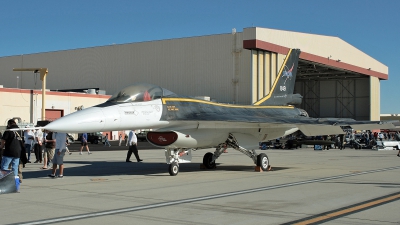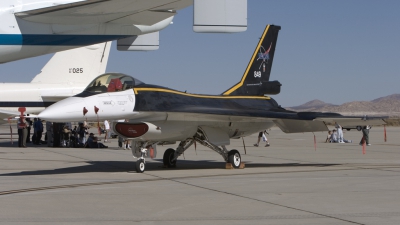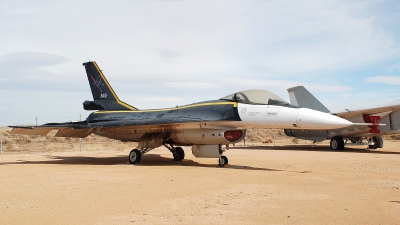General Dynamics F-16A/XL Fighting Falcon Aircraft Data
In February of 1980, General Dynamics made a proposal for a Fighting Falcon version with a radically-modified wing shape, which was originally proposed for use on supersonic airliners. The project was known as SCAMP (Supersonic Cruise and Manoeuvring Program) and later as F-16XL. The delta wing was to be of a cranked-arrow shape, with a total surface of 633 sq. ft. (more than double the area of the standard F-16 wing).
The research objectives included exploring innovative wing planform and camber shapes to provide efficient supersonic cruise performance while providing fighter-like transonic and supersonic turn agility. The design was intended to offer low drag at high subsonic or supersonic speeds without compromising low-speed manoeuvrability.
The fuselage was lengthened with 56 inches (142 cm) to 54 feet 1.86 inches by 'inserting' 2 new fuselage sections at the junctions between the three main fuselage sub-assemblies: one 26 inch (66 cm) section was inserted at the rear split point, and a 30 inch (76 cm) section at the front one. However, the rear 26in section, was not a continuous segment from the bottom to the top. Below the wing, a 26 inch segment was inserted just aft of the main landing gear, above the wing the segment was still 26 inches long, but inserted 26 inches farther aft than the segment below the wing. This made the section look like a backward "Z". The fuselage lengthening enabled the tail section to be canted up 3 degrees, necessary to prevent the engine nozzle from striking the runway during take off and landing.
The XL has no ventral fins for the same reason, but evidently did not need them, since the XL stability characteristics are in general superior to that of the F-16.
The engine inlet was only affected by the rear lower fuselage 26in extension, since the 30in forward fuselage extension was applied to the upper fuselage only. As a result, the F-16XL engine inlet is 26in longer than on a standard F-16A.
The wing planform was altered in a cranked-arrow delta wing (120% larger than the original F-16 wing), with extensive use of carbon composite materials (in the upper and lower layers of the skin) to save weight. Weight savings in the wings alone amounted to 600lbs. or 272kg. The wing is of multi-spar design with the leading edge sweep angle ranging from 50º to 70º, and is 2,800lbs (1,179 kg.) heavier than the original. The increase in internal volume (both by lengthening the fuselage and expanding the wing) allowed for a 82% increase in internal fuel capacity, while the increased wing area allowed the incorporation of up to 27 stores stations. Despite the apparent lengthening of the fuselage involved with the program, the new XL designation does NOT stand for "extra large".
Through wing planform improvements and camber optimizations, the final configuration offered a 25% improvement in maximum lift-to-drag ratio over the F-16 supersonically, and 11% improvement subsonic. The handling of the F-16XL was reportedly quite different from that of the standard F-16, offering a much smoother ride at high speeds and low altitudes. The configuration had matured into a very competent fighter with a large wing that allowed low-drag integration of large numbers of external weapons.
The research objectives included exploring innovative wing planform and camber shapes to provide efficient supersonic cruise performance while providing fighter-like transonic and supersonic turn agility. The design was intended to offer low drag at high subsonic or supersonic speeds without compromising low-speed manoeuvrability.
The fuselage was lengthened with 56 inches (142 cm) to 54 feet 1.86 inches by 'inserting' 2 new fuselage sections at the junctions between the three main fuselage sub-assemblies: one 26 inch (66 cm) section was inserted at the rear split point, and a 30 inch (76 cm) section at the front one. However, the rear 26in section, was not a continuous segment from the bottom to the top. Below the wing, a 26 inch segment was inserted just aft of the main landing gear, above the wing the segment was still 26 inches long, but inserted 26 inches farther aft than the segment below the wing. This made the section look like a backward "Z". The fuselage lengthening enabled the tail section to be canted up 3 degrees, necessary to prevent the engine nozzle from striking the runway during take off and landing.
The XL has no ventral fins for the same reason, but evidently did not need them, since the XL stability characteristics are in general superior to that of the F-16.
The engine inlet was only affected by the rear lower fuselage 26in extension, since the 30in forward fuselage extension was applied to the upper fuselage only. As a result, the F-16XL engine inlet is 26in longer than on a standard F-16A.
The wing planform was altered in a cranked-arrow delta wing (120% larger than the original F-16 wing), with extensive use of carbon composite materials (in the upper and lower layers of the skin) to save weight. Weight savings in the wings alone amounted to 600lbs. or 272kg. The wing is of multi-spar design with the leading edge sweep angle ranging from 50º to 70º, and is 2,800lbs (1,179 kg.) heavier than the original. The increase in internal volume (both by lengthening the fuselage and expanding the wing) allowed for a 82% increase in internal fuel capacity, while the increased wing area allowed the incorporation of up to 27 stores stations. Despite the apparent lengthening of the fuselage involved with the program, the new XL designation does NOT stand for "extra large".
Through wing planform improvements and camber optimizations, the final configuration offered a 25% improvement in maximum lift-to-drag ratio over the F-16 supersonically, and 11% improvement subsonic. The handling of the F-16XL was reportedly quite different from that of the standard F-16, offering a much smoother ride at high speeds and low altitudes. The configuration had matured into a very competent fighter with a large wing that allowed low-drag integration of large numbers of external weapons.
- Country of Origin: United States
- First Flight: 1982
- Initial Service Date:
- No. Built: 1
- No. In Service: 0
- No. of Hardpoints: 27
- Crew: 1
Power:
1 x Pratt & Whitney F100-PW-200 turbofan at 23,830 lbf
Weapons:
1 x 20mm M61A1 Vulcan cannon with 510 rounds
* 16 wing weapons stations (750 lb capacity)
* 4 semi-submerged AIM-120 stations
* 2 wingtip stations
* 1 centerline station
* 2 wing "heavy / wet" stations
* 2 chin stations for LANTIRN
* 16 wing weapons stations (750 lb capacity)
* 4 semi-submerged AIM-120 stations
* 2 wingtip stations
* 1 centerline station
* 2 wing "heavy / wet" stations
* 2 chin stations for LANTIRN
Dimensions:
| Length: | 54 ft. 2 in. |
| Wing Span: | 34 ft. 3 in. |
| Wing Area: | 633 sq.ft |
| Height: | 17 ft. 7 in. |
| Empty Weight: | 22,000 lbs |
| Max. Weight: | 48,000 lbs |
Performance:
| Max. Speed: | 1,260 mph |
| Service Ceiling: | 50,000 ft. |
| Max. Range: | 2,480 nm |

 Random great photos of the General Dynamics F-16A/XL Fighting Falcon:
Random great photos of the General Dynamics F-16A/XL Fighting Falcon:



